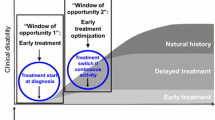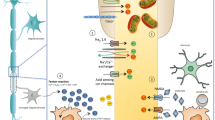Abstract
The McDonald diagnostic criteria have allowed the formal diagnosis of multiple sclerosis in patients presenting with clinically isolated syndromes to be brought forward. Evidence from research suggests that many patients with clinically isolated syndromes or early multiple sclerosis should be treated with disease-modifying drugs at an early stage, since disease experience during the first few years are likely to have significant impact on the long-term evolution of the disease. Histopathological studies have demonstrated the presence of axonal transection in patients with less than five years of disease duration, and especially during the first twelve months. Natural history studies have shown that the number of relapses occurring during the first few years of the disease is related to the time to accrued disability. Moreover, longitudinal studies on patients with clinically isolated syndromes have shown that the presence of even a very small number of baseline MRI lesions is associated with an increased risk of developing clinically definite multiple sclerosis and, more importantly, that the increase in volume of the lesions seen in the first five years correlates with the degree of disability in the longer term. For example, long-term follow-up of a large cohort of patients presenting with a clinically isolated syndrome in Barcelona has shown that the number of Barkhof criteria fulfilled at baseline was correlated with the risk of relapse, EDSS disability scores at five years and the risk of reaching given EDSS disability thresholds. Three randomised clinical trials in patients with a clinically isolated syndrome and abnormal brain MRI have shown significant benefit of initiating early therapy with β-interferons, and a similar study is underway with glatiramer acetate. It is concluded that choosing the right time to introduce treatment is critically important for outcome and the earlier treatment is initiated, the better the outcome.
Similar content being viewed by others
References
Barkhof F, Filippi M, Miller DH, Scheltens P, Campi A, Polman CH, Comi G, Ader HJ, Losseff N, Valk J (1997) Comparison of MRI criteria at first presentation to predict conversion to clinically definite multiple sclerosis. Brain 120(Pt 11):2059–2069
Brex PA, Ciccarelli O, O'Riordan JI, Sailer M, Thompson AJ, Miller DH (2002) A longitudinal study of abnormalities on MRI and disability from multiple sclerosis. N Engl J Med 346:158–164
Coles AJ, Cox A, Le Page E, Jones J, Trip SA, Deans J, Seaman S, Miller DH, Hale G, Waldmann H, Compston DA (2006) The window of therapeutic opportunity in multiple sclerosis: evidence from monoclonal antibody therapy. J Neurol 253:98–108
Comi G, Filippi M, Barkhof F, Durelli L, Edan G, Fernandez O, Hartung H, Seeldrayers P, Sorensen PS, Rovaris M, Martinelli V, Hommes OR (2001) Effect of early interferon treatment on conversion to definite multiple sclerosis: a randomised study. Lancet 357:1576–1582
Filippi M, Rovaris M, Inglese M, Barkhof F, De Stefano N, Smith S, Comi G (2004) Interferon beta-1a for brain tissue loss in patients at presentation with syndromes suggestive of multiple sclerosis: a randomised, double-blind, placebo-controlled trial. Lancet 364:1489–1496
Fisniku L, Brex P, Altmann D, Miszkiel K, Thompson A, Miller D (2006) Disability status and the relationship between the T2-MRI abnormalities in CIS patients and the long-term outcome in a 20-year follow-up. Mult Scler 12(Suppl 1):S1
Hohlfeld R, Kerschensteiner M, Stadelmann C, Lassmann H, Wekerle H (2000) The neuroprotective effect of inflammation: implications for the therapy of multiple sclerosis. J Neuroimmunol 107:161–166
Jacobs LD, Beck RW, Simon JH, Kinkel RP, Brownscheidle CM, Murray TJ, Simonian NA, Slasor PJ, Sandrock AW (2000) Intramuscular interferon beta-1a therapy initiated during a first demyelinating event in multiple sclerosis. CHAMPS Study Group. N Engl J Med 343:898–904
Kappos L, Polman CH, Freedman MS, Edan G, Hartung HP, Miller DH, Montalban X, Barkhof F, Bauer L, Jakobs P, Pohl C, Sandbrink R (2006) Treatment with interferon beta-1b delays conversion to clinically definite and McDonald MS in patients with clinically isolated syndromes. Neurology 67:1242–1249
Kinkel RP, Kollman C, O'Connor P, Murray TJ, Simon J, Arnold D, Bakshi R, Weinstock-Gutman B, Brod S, Cooper J, Duquette P, Eggenberger E, Felton W, Fox R, Freedman M, Galetta S, Goodman A, Guarnaccia J, Hashimoto S, Horowitz S, Javerbaum J, Kasper L, Kaufman M, Kerson L, Mass M, Rammohan K, Reiss M, Rolak L, Rose J, Scott T, Selhorst J, Shin R, Smith C, Stuart W, Thurston S, Wall M (2006) IM interferon beta-1a delays definite multiple sclerosis 5 years after a first demyelinating event. Neurology 66:678–684
Kuhlmann T, Lingfeld G, Bitsch A, Schuchardt J, Bruck W (2002) Acute axonal damage in multiple sclerosis is most extensive in early disease stages and decreases over time. Brain 125:2202–2212
Langer-Gould A, Popat RA, Huang SM, Cobb K, Fontoura P, Gould MK, Nelson LM (2006) Clinical and demographic predictors of long-term disability in patients with relapsing-remitting multiple sclerosis: a systematic review. Arch Neurol 63:1686–1691
McDonald WI, Compston A, Edan G, Goodkin D, Hartung HP, Lublin FD, McFarland HF, Paty DW, Polman CH, Reingold SC, Sandberg-Wollheim M, Sibley W, Thompson A, van den Noort S, Weinshenker BY, Wolinsky JS (2001) Recommended diagnostic criteria for multiple sclerosis: guidelines from the International Panel on the diagnosis of multiple sclerosis. Ann Neurol 50:121–127
Morrissey SP, Miller DH, Kendall BE, Kingsley DP, Kelly MA, Francis DA, MacManus DG, McDonald WI (1993) The significance of brain magnetic resonance imaging abnormalities at presentation with clinically isolated syndromes suggestive of multiple sclerosis. A 5-year follow-up study. Brain 116(Pt 1):135–146
Multiple Sklerose Therapie Konsensus Gruppe (MSTKG), Rieckmann P (2006) Immunmodulatorische Stufentherapie der Multiplen Sklerose. Der Nervenarzt 77:1506–1518
O'Riordan JI, Thompson AJ, Kingsley DP, MacManus DG, Kendall BE, Rudge P, McDonald WI, Miller DH (1998) The prognostic value of brain MRI in clinically isolated syndromes of the CNS. A 10-year follow-up. Brain 121(Pt 3):495–503
Pittock SJ, McClelland RL, Mayr WT, Jorgensen NW, Weinshenker BG, Noseworthy J, Rodriguez M (2004) Clinical implications of benign multiple sclerosis: a 20-year population-based follow-up study. Ann Neurol 56:303–306
Poser CM, Paty DW, Scheinberg L, McDonald WI, Davis FA, Ebers GC, Johnson KP, Sibley WA, Silberberg DH, Tourtellotte WW (1983) New diagnostic criteria for multiple sclerosis: guidelines for research protocols. Ann Neurol 13:227–231
Tintoré M, Rovira A, Rio J, Nos C, Grive E, Sastre-Garriga J, Pericot I, Sanchez E, Comabella M, Montalban X (2003) New diagnostic criteria for multiple sclerosis: application in first demyelinating episode. Neurology 60:27–30
Tintoré M, Rovira A, Rio J, Nos C, Grive E, Tellez N, Pelayo R, Comabella M, Sastre-Garriga J, Montalban X (2006) Baseline MRI predicts future attacks and disability in clinically isolated syndromes. Neurology 67:968–972
Trapp BD, Peterson J, Ransohoff RM, Rudick R, Mork S, Bo L (1998) Axonal transection in the lesions of multiple sclerosis. N Engl J Med 338:278–285
Weinshenker BG, Bass B, Rice GP, Noseworthy J, Carriere W, Baskerville J, Ebers GC (1989) The natural history of multiple sclerosis: a geographically based study. 2. Predictive value of the early clinical course. Brain 112(Pt 6):1419–1428
Weinshenker BG, Bass B, Rice GP, Noseworthy J, Carriere W, Baskerville J, Ebers GC (1989) The natural history of multiple sclerosis: a geographically based study. I. Clinical course and disability. Brain 112(Pt 1):133–146
Author information
Authors and Affiliations
Corresponding author
Rights and permissions
About this article
Cite this article
Tintoré, M. Rationale for early intervention with immunomodulatory treatments. J Neurol 255 (Suppl 1), 37–43 (2008). https://doi.org/10.1007/s00415-008-1006-4
Issue Date:
DOI: https://doi.org/10.1007/s00415-008-1006-4




